A set is a well defined collection of distinct objects.
In generally, i.e., collection of numbers, collection of letters, collection of pack of cards, a crowd of people, a cricket team etc.
In mathematics, i.e., collection of natural numbers, real numbers, odd numbers, even numbers etc.
There have mainly two methods to represent the set :
(i) Tabular form or Roster form,
(ii) Set-builder form
In Tabular or Roster form, all elemnets are separated by braces "{ }".
e.g., (a) collections of all vowels in english alphabets {a, e, i, o, u}.
(b) Collections of all Natural numbers {1, 2, 3, 4,....}
In the set-builder form, all the elements of the set, must possess a single property to become the member of that set.
e.g., (a) {a, e, i, o, u} = {x : x is a vowels in english alphabets}.
(b) {1, 2, 3, 4,....} = {x : x is all Natural numbers}.
There have mainly seven types of Sets :
(i) Empty or Null Sets,
(ii) Equal Sets,
(iii) Finite and Infinite Sets,
(iv) Subsets,
(v) Power Sets,
(vi) Universal Sets
(vii) Equivalent Sets
A set which does not contain any element is called empty set. It is denoted by '{}' or 'φ'. But {φ} is not a empty set.
e.g., A = { } and B = φ.
Equal sets are those sets in which two sets A and B have exactly the same elements.
e.g., (a) {a, e, i, o, u} = {x : x is a vowels in english alphabets}.
(b) {1, 2, 3, 4,....} = {x : x is all Natural numbers}.
A set which consists of a definite number of elements is called finite set, and A set which consists of a indefinite number of elements is called infinite set.
e.g., (a) A = {a, e, i, o, u} is called finite set.
(b) {1, 2, 3, 4,....} is called infinite set.
A set A is said to be subset of a set B, if every element of A is also an element of B and its vice-versa. It is denoted by '⊂'.
e.g., A = {3, 4} and B = {1, 2, 3, 4, 5}
Here every elemnt of A is also an element of B. So, A ⊂ B.
A power set of a set A is collection of all subsets of A. It is denoted by P(A)and its general form is 2ⁿ; Here n = number of elements.
e.g., A = {1, 2, 3}
n = 3; 2³ = 8
P(A) = {φ, {1}, {2}, {3}, {1,2}, {2,3}, {1,3}, {1,2,3}}.
A universal set is the collection of all elements in a particular context. It is denoted as an uppercase italic letter 'U'.
e.g., A = {1, 2, 3}, B = {4, 5, 6} and C = {7, 8}
U = {1, 2, 3, 4, 5, 6, 7, 8}.
Let A and B have two sets and number of elements of set A and set B are equal. i.e., called Equivalent set.
e.g., A = {a, b, c}, B = {4, 5, 6}
A and B are equivalent set.
Most of the relationships between sets can be represented by means of diagrams which are known as Venn diagram.
In Venn diagrams, the elements of the sets are written in their respective circles.
e.g.,
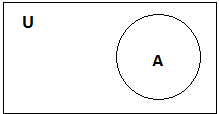
There are following operations of sets :
(i) Union of Sets,
(ii) Intersection of Sets,
(iii) Differece of Sets,
(iv) Complement of Sets
(v) Symmetric Difference of Sets
(vi) Disjoint of Sets
(vii) Singleton Sets
Let A and B be any two sets. The union of A and B is the set which consists of all the elements of A and all the elements of B,
the common elements being taken only once. The symbol ‘∪’ is used to denote the union. Symbolically, we write A ∪ B.
e.g., A = {1, 2, 3, 4} and B = {4, 5, 6}
A ∪ B = {1, 2, 3, 4, 5, 6}.
Venn Diagram :
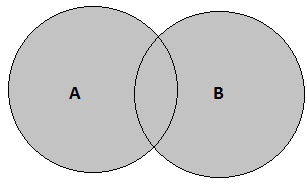
The intersection of sets A and B is the set of all elements which are common to both A and B. The symbol ‘∩’ is used to denote the intersection.
Symbolically, we write A ∩ B.
e.g., A = {1, 2, 3, 4} and B = {1, 4, 5, 6}
A ∩ B = {1, 4}.
Venn Diagram :
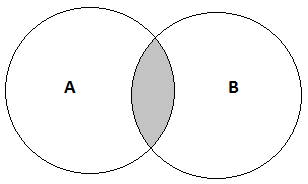
The difference of the sets A and B in this order is the set of elements which belong to A but not to B.
Symbolically, we write A – B and read as “ A minus B ”.
e.g., A = {1, 2, 3, 4} and B = {1, 4, 5, 6}
A - B = {2, 3}.
Venn Diagram :
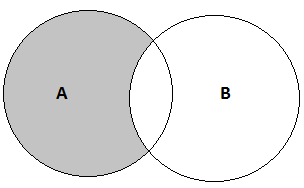
B - A = {5, 6}.
Venn Diagram :
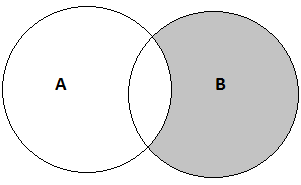
The complement of a subset A of universal set U is the set of all elements of U which are not the elements of A.
Symbolically, we write A'.
e.g., A = {1, 2, 3} and U = {1, 2, 3, 4, 5, 6, 7, 8}.
A' = U - A = {4, 5, 6, 7, 8}.
Venn Diagram :
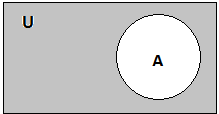
In set theory, the symmetric difference of two sets A and B is the set of elements either in A or in B but not in both.
Symbolically, we write A ∆ B. It means that (A - B) U (B - A).
e.g., A = {1, 2, 3, 4} and B = {3, 4, 5, 6}.
A - B = {1, 2} and B - A = {5, 6}
A ∆ B = (A - B) U (B - A) = {1, 2, 5, 6}
Venn Diagram :
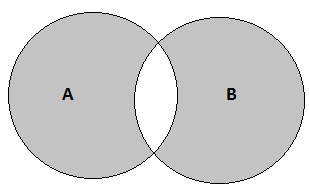
If A and B are two sets such that A ∩ B = φ, then A and B are called disjoint sets.
e.g., A = {1, 2, 3, 4} and B = {5, 6}
Then A and B are disjoint sets.
Venn Diagram :
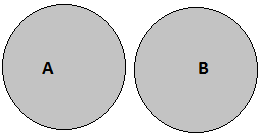
If a set A has only one element, we call it a singleton set. Thus, { a } is a singleton set.
e.g., A = { 2 } is a singleton set.
Let a, b ∈ R and a < b. Then the set of real numbers { y : a < y < b} is called an open interval and is denoted by (a, b).
All the points between a and b belong to the open interval (a, b) but a, b themselves do not belong to this interval.
i.e., [ a, b ) = {x : a ≤ x < b} is an open interval from a to b, including a but excluding b.
( a, b ] = { x : a < x ≤ b } is an open interval from a to b including b but excluding a.
( a, b ) = {x : a < x < b} is an is an open interval from a to b excluding a and b.
e.g., (a) (–5, 7] = {x : x ∈ R, –5 < x ≤ 7}
(b) [–5, 7) = {x : x ∈ R, –5 ≤ x < 7}
(c) (–5, 7) = {x : x ∈ R, –5 < x < 7}
The interval which contains the end points also is called closed interval and is denoted by [ a, b ].
Thus [ a, b ] = {x : a ≤ x ≤ b} We can also have intervals closed at one end and open at the other.
e.g., [-5, 7] = {x : x ∈ R, –5 ≤ x ≤ 7}

Let A and B be two sets. If A ⊂ B and A ≠ B , then A is called a proper subset of B and B is called superset of A.
e.g., A = {1, 2, 3} is a proper subset of B = {1, 2, 3, 4}.